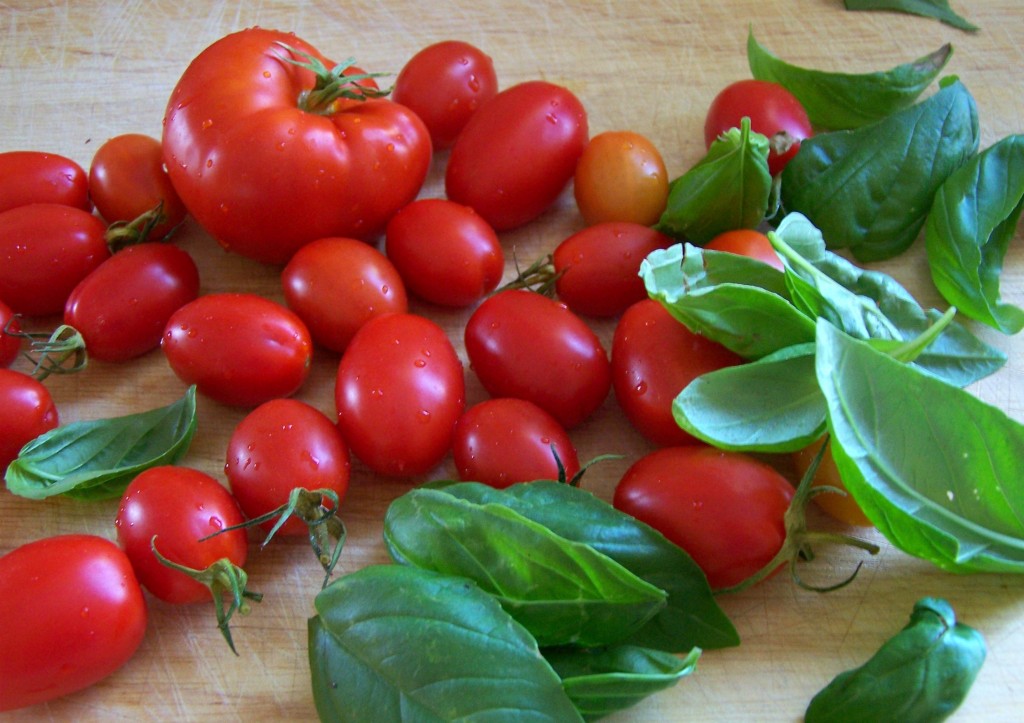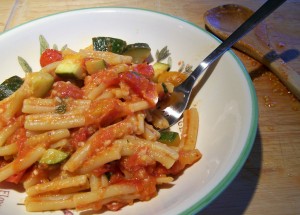This post is a guest post by CFN customer, mom and writer Leah over at Leah’s Thoughts.

One of the things I am most proud of in my life is making a commitment to eating locally –grown, organic produce and supporting community businesses. My family and I recently took this commitment to eating locally even closer to home — our own backyard!
My husband, Bryan, has always been interested in growing produce in our yard. Some crops have worked well (lemons, tomatoes, plums). Other crops probably needed more help (avocados). Last year, Bryan and our 4-year-old daughter, Sophie, planted a few tomato plants in our yard and they flourished. In fact, one of Sophie’s favorite activities was running into the backyard and picking red tomatoes to show Bryan. Then she leaves them on the kitchen table for me to cook.
I have also had luck in planting little herb pots for fresh basil, parsley, chives and thyme that I love using in my kitchen concoctions.
After noticing a very full bowl of backyard tomatoes and lots of basil that needed picking, I decided to put our locally-grown, organic produce to action by making one of my all-time favorite tasty and healthy dishes — Tomato Basil Pasta. This dish is SO easy and simple, yet beyond flavorful.
I don’t have an actual recipe or measurements for this dish since it depends on how much produce I have available. I’ll do my best to tell you how to make it. You really can’t mess it up, honestly!
Tomato Basil Pasta Recipe
Here’s what you need:
- 1/4c - olive oil
- 1-1/2 c - tomatoes, chopped (I always use fresh)
- 6 - 8 medium leaves - basil, chopped
- 1/2 tsp - garlic
- 1/2 tsp - salt
- 1/2 tsp - pepper
- Parmesan cheese - to taste (vegans and those will allergies can omit)
- 1, 16oz box of pasta. (I use penne, or whatever is in the pantry. Gluten free pastas will work, too. Just follow cooking instructions on the box!)
Heat the olive oil in a pan (maybe 1/4 cup), and add chopped tomatoes. Let them cook over a medium-low heat until it comes saucy, yet still chunky with your freshly picked tomatoes. Then add ½ tsp. garlic, salt and pepper. ALWAYS add salt and pepper when you cook, not after. It bring out the flavor more.
While all this is going on, cook the pasta (about 1 pound) to al dente. Once the sauce becomes a thick and yummy consistency, add the chopped basil and the cooked pasta. Then add Parmesan cheese. Let the pasta sit for a few minutes so all the flavors absorb together. Taste it for seasoning and, voila, you’re done!
This dish is so simple, so delicious, and so healthy. And when you make it with produce you’ve grown with your own two hands, it is SO fresh and satisfying! Trust me – you will want to grow your own tomatoes and herbs for this one. You will love it!
Leah Singer is a San Diego-based freelance writer. She blogs at Leah’s Thoughts about topics such as family, motherhood, traditions, cooking, writing, photography, and literature. She’s also an avid tweeter (@leahs_thoughts) and a self-proclaimed Facebook junkie.




